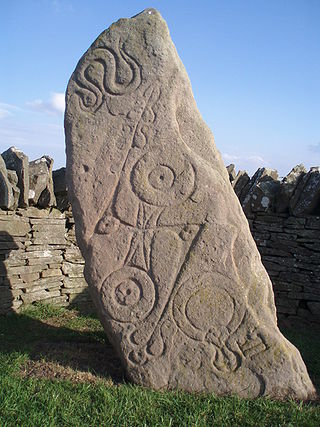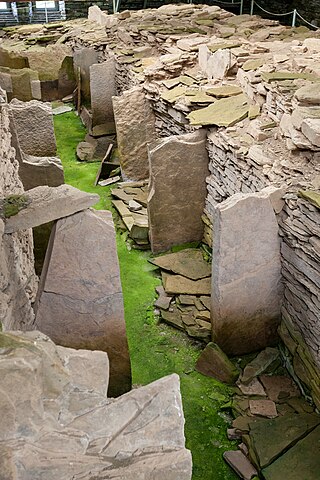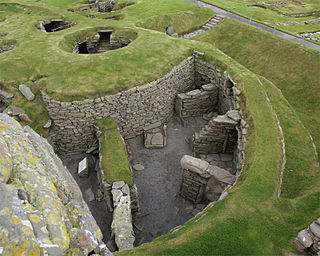
Painted pebbles are a class of Early Medieval artifact found in northern Scotland dating from the first millennium CE.

Painted pebbles are a class of Early Medieval artifact found in northern Scotland dating from the first millennium CE.
They are small rounded beach pebbles made of quartzite, which have been painted with simple designs in a dye which is now dark brown in colour. The size varies from 18 by 22 millimetres (0.71 by 0.87 in) to 65 by 51 millimetres (2.6 by 2.0 in). It has not proven possible to analyse the dye itself from the stains that remain.
The motifs are carefully executed and the most common are dots and wavy lines. Other motifs are small circles, pentacles, crescents and triangles, showing strong relationships with the Pictish symbol stone motifs. [1]
Experimental archaeology suggests that the designs were likely to have been painted with peat tar. [2]
To date, 55 painted pebbles have been found. 11 of these were found in Caithness, 5 in Orkney and 27 in Shetland. [2] Most have come from broch sites which have been shown to have had an extensive post-broch occupation. An ogham-inscribed spindle-whorl was associated with one find at Buckquoy in Orkney (see Buckquoy spindle whorl). Several have been associated with wheelhouses or their outbuildings. An example was found at a Pictish site at Buckquoy in Orkney as reported in 1976. It had the "small ring" type decoration. [3]
Scottish painted pebbles have been dated to the period 200 AD to the eighth century AD, the Pictish period. They may have been sling-stones that were thought to be of magical nature by the Picts; however, local traditions suggest that they were "charm-stones", often known as "cold-stones". Such stones were used within living memory to cure sickness in animals and humans. [1]
In the Life of St. Columba it is recorded that he visited King Bridei in Pictland in around the year 565 AD and, taking a white stone pebble from the River Ness, he blessed it and any water it came into contact with would cure sick people. It floated in water and cured the king from a terminal illness. It remained as one of the great treasures of the king and cured many others.

Orkney, also known as the Orkney Islands, is an archipelago in the Northern Isles of Scotland, situated off the north coast of the island of Great Britain. Orkney is 10 miles (16 km) north of the coast of Caithness and has about 70 islands, of which 20 are inhabited. The largest island, the Mainland, has an area of 523 square kilometres (202 sq mi), making it the sixth-largest Scottish island and the tenth-largest island in the British Isles. Orkney’s largest settlement, and also its administrative centre, is Kirkwall.

The Picts were a group of peoples who lived in what is now northern and eastern Scotland during Late Antiquity and the Early Middle Ages. Where they lived and what their culture was like can be inferred from early medieval texts and Pictish stones. Their Latin name, Picti, appears in written records from the 3rd to the 10th century. Early medieval sources report the existence of a distinct Pictish language, which today is believed to have been an Insular Celtic language, closely related to the Brittonic spoken by the Britons who lived to the south.
Pictish is the extinct Brittonic language spoken by the Picts, the people of eastern and northern Scotland from Late Antiquity to the Early Middle Ages. Virtually no direct attestations of Pictish remain, short of a limited number of geographical and personal names found on monuments and the contemporary records in the area controlled by the kingdoms of the Picts, dating to the early medieval period. Such evidence, however, points strongly to the language being an Insular Celtic language related to the Brittonic language spoken prior to Anglo-Saxon settlement in what is now southern Scotland, England, and Wales.

The Northern Isles are a pair of archipelagos off the north coast of mainland Scotland, comprising Orkney and Shetland. They are part of Scotland, as are the Hebrides. The climate is cool and temperate and much influenced by the surrounding seas. There are a total of 36 inhabited islands. The landscapes of the fertile agricultural islands of Orkney contrast with the more rugged Shetland islands to the north, where the economy is more dependent on fishing and on the oil wealth of the surrounding seas. Both island groups have a developing renewable energy industry. Both have a Pictish and Norse history. Both were part of the Kingdom of Norway until they were absorbed into the Kingdom of Scotland in the 15th century. They remained part of it until the 1707 formation of the Kingdom of Great Britain and the 1801 formation of the United Kingdom. They both played a significant naval role during the world wars of the 20th century.

Jarlshof is the best-known prehistoric archaeological site in Shetland, Scotland. It lies in Sumburgh, Mainland, Shetland and has been described as "one of the most remarkable archaeological sites ever excavated in the British Isles". It contains remains dating from 2500 BC up to the 17th century AD.

A charmstone or coldstone is a stone or mineral artifact of various types associated with various traditional cultures, including those of Scotland and the native cultures of California and the American southwest. Typically they are elongated or cylindrical and have been shaped by grinding or other human activity, and may be perforated and/or grooved. They are thought to have been regarded as having some religious or magical function, including being talismans, amulets or charms.

Broch of Mousa is a preserved Iron Age broch or round tower. It is on the island of Mousa in Shetland, Scotland. It is the tallest broch still standing and amongst the best-preserved prehistoric buildings in Europe. It is thought to have been constructed c. 100 BC, and is one of more than 500 brochs built in Scotland. The site is managed by Historic Environment Scotland as a scheduled monument.

A Pictish stone is a type of monumental stele, generally carved or incised with symbols or designs. A few have ogham inscriptions. Located in Scotland, mostly north of the Clyde-Forth line and on the Eastern side of the country, these stones are the most visible remaining evidence of the Picts and are thought to date from the 6th to 9th century, a period during which the Picts became Christianized. The earlier stones have no parallels from the rest of the British Isles, but the later forms are variations within a wider Insular tradition of monumental stones such as high crosses. About 350 objects classified as Pictish stones have survived, the earlier examples of which holding by far the greatest number of surviving examples of the mysterious symbols, which have long intrigued scholars.

Edin's Hall Broch is a 2nd-century broch near Duns in the Borders of Scotland. It is one of very few brochs found in southern Scotland. It is roughly 28 metres in diameter.

The Buckquoy spindle-whorl is an Ogham-inscribed spindle-whorl dating from the Early Middle Ages, probably the 8th century, which was found in 1970 in Buckquoy, Birsay, Orkney, Scotland. Made of sandy limestone, it is about 36 mm in diameter and 10 mm thick. It is the only known spindle-whorl with an Ogham inscription.
The Lunnasting stone is a stone bearing an ogham inscription, found at Lunnasting, Shetland and donated to the National Museum of Antiquities of Scotland in 1876.

Scotland was divided into a series of kingdoms in the early Middle Ages, i.e. between the end of Roman authority in southern and central Britain from around 400 CE and the rise of the kingdom of Alba in 900 CE. Of these, the four most important to emerge were the Picts, the Gaels of Dál Riata, the Britons of Alt Clut, and the Anglian kingdom of Bernicia. After the arrival of the Vikings in the late 8th century, Scandinavian rulers and colonies were established on the islands and along parts of the coasts. In the 9th century, the House of Alpin combined the lands of the Scots and Picts to form a single kingdom which constituted the basis of the Kingdom of Scotland.

Prehistoric Orkney refers only to the prehistory of the Orkney archipelago of Scotland that begins with human occupation. Although some records referring to Orkney survive that were written during the Roman invasions of Scotland, “prehistory” in northern Scotland is defined as lasting until the start of Scotland's Early Historic Period.

Midhowe Chambered Cairn is a large Neolithic chambered cairn located on the south shore of the island of Rousay, Orkney, Scotland. The name "Midhowe" comes from the Iron Age broch known as Midhowe Broch, that lies just west of the tomb. The broch got its name from the fact that it's the middle of three such structures that lie grouped within 500 metres (1,600 ft) of each other and Howe from the Old Norse word haugr meaning mound or barrow. Together, the broch and chambered cairn form part of a large complex of ancient structures on the shore of Eynhallow Sound separating Rousay from Mainland, Orkney.

Prehistoric Shetland refers to the prehistoric period of the Shetland archipelago of Scotland, when it was first occupied by humans. The period prior to human settlement in Shetland is known as the geology of Scotland. Prehistory in Shetland does not end until the beginning of the Early Medieval Period in Scotland, around AD 600. More than 5,000 archaeological sites have been recorded in the Shetland Islands.

Katherine S. Forsyth is a Scottish historian who specializes in the history and culture of Celtic-speaking peoples during the 1st millennium AD, in particular the Picts. She is currently a professor in Celtic and Gaelic at the University of Glasgow in Scotland.

The Broch of Borwick is an Iron Age broch located on Mainland, Orkney, Scotland. It is a scheduled monument.

The Broch of Burrian is an Iron Age broch located on North Ronaldsay in the Orkney Islands, in Scotland.

Clumlie Broch is an Iron Age broch located on Mainland, Shetland, in Scotland.

Dr Anna Ritchie OBE, BA, PhD, FSA, Hon FSA Scot is a British archaeologist and historian.